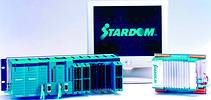

Earlier this year Yokogawa Electric Corporation upgraded the autonomous controllers for its new concept, Stardom network-based control system. The upgraded system, Release 1.60, is available.
Stardom is made up of function-specific control, operation, and monitoring components that can be interconnected flexibly, and scaled, using networking technology. The system has both the reliability and supportability of distributed control systems (DCSs) and the openness, versatility, and cost-effectiveness of systems that combine PCs, programmable logic controllers (PLCs), and other devices. Stardom is a core building block of Yokogawa's VigilantPlant solutions that is aimed at bringing operational excellence to visionary plants - and creating an environment where plant personnel can see clearly, know in advance, and act with agility.
In line with Yokogawa's fundamental commitment to steadily introduce new functions and improve reliability, the company is continually making enhancements to Stardom. With the development of Release 1.60, program handling has been enhanced in Stardom autonomous controllers that have a redundant CPU configuration - and CPU-to-CPU equalisation processing has been sped up. In addition, six new HART communication-enabled modules have been added to the product line-up.
The company will make functional enhancements on an on-going basis, with the aim of increasing Stardom's range of applications and expanding business.
Development background
In the energy field, there is a growing demand for network-based monitoring and control systems at oil and natural gas extraction facilities, as well as in upstream processing equipment and pipelines. General-purpose PLCs have often proved to lack the capacity that this field requires. The demand is therefore growing for monitoring and control systems that feature high reliability, high information handling capacity, and compatibility with a wide range of networks and which can be implemented at low costs. Capital investment is also brisk with high-value added raw materials such as fine chemicals and semiconductor materials, and in the foods, pharmaceuticals, and iron and steel fields. As continuous processes (liquid processing, for example) often coexist with discrete processes (assembly and machining) in each of these fields, an increasing number of users are turning to PLC-based control systems, most of which are small to medium-scale. As an increasing number of these systems have field devices, particularly transmitters, that use the HART protocol, it has become essential for support of this protocol to be added to Stardom. The functional enhancements in Release 1.60 are in response to these requirements.
Overview of functional enhancements
Increased processing speed for redundant CPU configuration
Program processing with redundant CPU configuration is 1,5 times faster. Consequently, it is now possible to introduce the autonomous controllers to processes such as compressor control that require high reliability and fast response. CPU-to-CPU equalisation processing is 20 times faster; it is now possible to replace and repair one of the CPU boards in the redundant CPU configuration while the plant is still in operation.
Release of six new HART protocol-compliant modules
Since many field devices currently used in upstream processes such as oil and natural gas extraction and pipeline transportation employ the HART protocol, the following six HART-compliant I/O modules have been added to the product line-up:
* Collectively-isolated, 16-channel current input module.
* Non-isolated, 16-channel current input module.
* Individually-isolated, 8-channel current input module.
* Collectively-isolated, 16-channel current output module.
* Non-isolated, 8-channel current input/8-channel current output module.
* Individually-isolated, 4-channel current input/4-channel current output module.
Major target markets
Oil and natural gas extraction facilities, upstream process equipment and pipelines; widely-distributed facilities including water-processing plants and cogeneration equipment; small to medium-scale process-related plants including oil, chemical and water purification plants; and a wide range of small to medium-scale production facilities including food and pharmaceutical plants.
Applications
The overall operation, monitoring and control of various types of equipment including:
* Monitoring and control of widely-distributed production facilities.
* Remote monitoring and control of district heating/cooling and cogeneration equipment.
* Remote monitoring and control of semiconductor manufacturing equipment.
* Energy conservation monitoring and control.
About the HART protocol
To enable the transmission of multiple signals, the highway addressable remote transducer (HART) protocol superimposes digital signals onto the 4 to 20 mA analog control signals used in many plants. Many control equipment manufacturers have joined the HART Communication Foundation (HCF).
For more information, visit www.hartcomm.org
For more information contact Johan Pretorius, Yokogawa, 011 681 2560, [email protected], www.yokogawa.com

© Technews Publishing (Pty) Ltd | All Rights Reserved